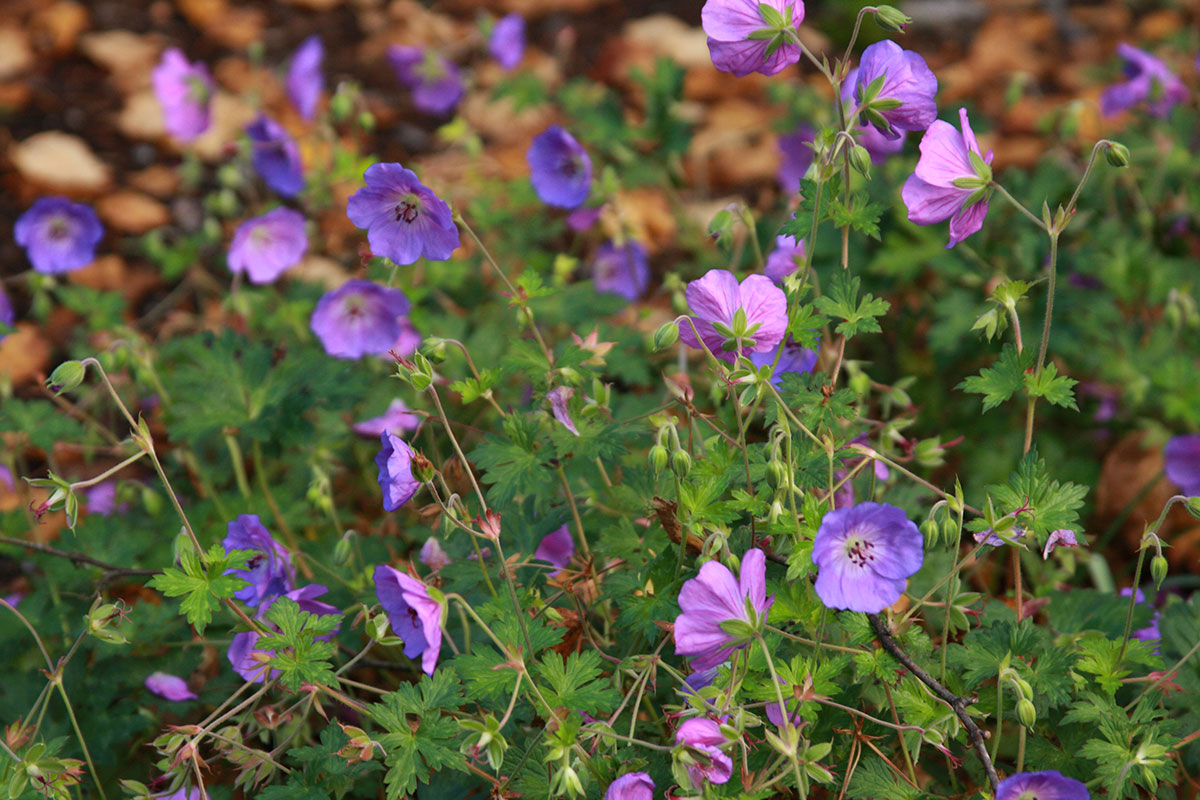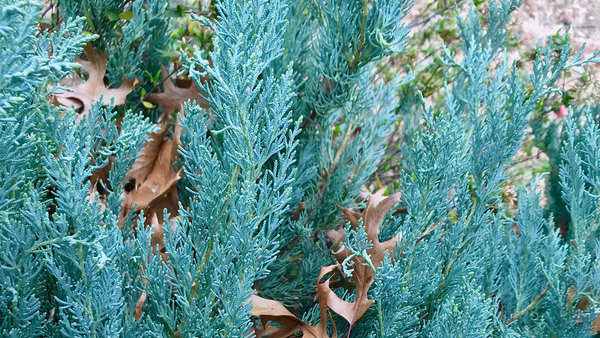
The color blue evokes pleasant feelings of tranquility and harmony. Blue hues appear to be refreshing as well as calming and soothing to body and mind.
In the garden, blue flowers and foliage can appear to recede into the background, making brighter, warmer colors pop even more vividly. There are many shades of blue, ranging from the darkest midnight blue to the palest pastel powder blue, and almost every one of these shades can be found infusing something in the plant world, whether it is blossoms, berries, or foliage. Here are just a few of my favorite blue plants for Northern California.
The Bluest Berries

Pick any ripe blueberry (Vaccinium corymbosum, Zones 5–10), and relish blue at its very best. Lesser known, the highly ornamental Blaze™ Tasman flax lily (Dianella tasmanica ‘NPW2’, Zones 8–11) produces beautiful and edible royal-blue berries containing tiny, nutty seeds.
The Bluest Blooms

‘Rozanne’ geranium
Geranium ‘Rozanne’, Zones 3–8
‘Rozanne’ geranium is a long-blooming beauty whose mound of deep green, deeply cut foliage is covered with saucer-shaped violet-blue flowers all summer and through fall. A fabulous low-growing perennial, this geranium is perfect for the front of a perennial border. It reaches 12 to 18 inches tall and spreads nicely to 20 inches wide in full sun to partial shade. Plant it in rich soil, and give it regular irrigation.

‘Elsa Spath’ clematis
Clematis ‘Elsa Spath’, Zones 4–9
This easy-to-grow queen of climbers puts on its first spectacular display of large (8 inches in diameter) lavender-blue blooms in June. It will happily repeat the show-stopping performance if you follow just two simple tips: Prune it back by half after its first flush of blooms is spent, and feed it with a well-balanced fertilizer. Exceptionally floriferous and vigorous, ‘Elsa Spath’ grows best in rich soil with afternoon shade near a trellis, pergola, climbing rose, or arbor.

Blue felicia daisy
Felicia ‘Cape Town Blue’, Zones 9–11
A charming, tidy, evergreen perennial, this long-blooming South African native works wonderfully in our climate, brightening up beds, borders, or containers with its long-lasting spring-through-fall display of delightful blue-and-yellow flowers. These blooms positively pop against bright green foliage. Plant this easy-care daisy in full sun and amended soil, and water lightly but regularly.
The Bluest Foliage
True blue is more readily found in blooms and berries, but blue-tinged foliage can add a layer of intensity to the landscape when combined with brighter, bolder colors such as yellow, purple, or coral red. A more muted tapestry is created when swaths of duskier blue foliage plants are grown alongside calmer greens or butter yellows. Shades of blue soothe an overheated Northern California garden even on the warmest days, offering a restful visual respite just when it’s most needed.

Beyond Blue™ blue fescue
Festuca glauca ‘Casca11’, Zones 4–11
Whether accenting a pretty container, edging walkways, or massed in a meadow, the dense tufts of this fescue’s fine-bladed foliage are intensely powder blue. Growing up to 12 inches tall and 16 inches wide, Beyond Blue™ has a soft texture and bright, year-round color, with buff-colored flower panicles adding summer interest. This evergreen ornamental grass is among the best and brightest of the blue fescues and is easy to grow in full sun when planted in well-drained soil. It’s also drought tolerant and deer proof once established.

Donkeytail spurge
Euphorbia myrsinites, Zones 5–10
This low-growing, succulent-like evergreen perennial has foliage with an intriguing texture. Its sprawling stems are clothed in spirals of silver-blue leaves and a late winter display of bright chartreuse blooms that appear at the end of its long stems and age gracefully to a soft, dusky pink by March. Growing 6 inches tall and 12 to 16 inches wide, this euphorbia self-seeds politely when happy. Like Beyond Blue™ blue fescue, it’s also drought tolerant, deer proof, and easy to care for. Give it full sun and well-drained soil. It’s a great pick for dry gravel gardens!

‘Blue Mouse Ears’ hosta
Hosta ‘Blue Mouse Ears’, Zones 3–8
Tiny, tidy, perfectly proportioned mounds of thick, blue-green leaves (resembling the cutest mouse ears ever) appear in early spring when this dwarf hosta emerges from dormancy. Lavender, bell-like blooms appear above the foliage in midsummer. As lovely as they are, they’re almost secondary to the gorgeous hue and texture of the foliage. Reaching 6 to 7 inches tall and 12 inches wide, this herbaceous perennial requires shade from afternoon sun and prefers rich, well-amended soil and regular irrigation.
—Fionuala Campion is the owner and manager of Cottage Gardens of Petaluma in Petaluma, California.
Fine Gardening Recommended Products

The Crevice Garden: How to make the perfect home for plants from rocky places
Fine Gardening receives a commission for items purchased through links on this site, including Amazon Associates and other affiliate advertising programs.

ARS Telescoping Long Reach Pruner
Fine Gardening receives a commission for items purchased through links on this site, including Amazon Associates and other affiliate advertising programs.

Planting in a Post-Wild World: Designing Plant Communities for Resilient Landscapes
Fine Gardening receives a commission for items purchased through links on this site, including Amazon Associates and other affiliate advertising programs.



















Comments
Log in or create an account to post a comment.
Sign up Log in